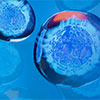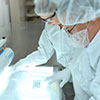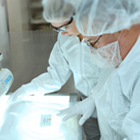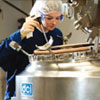Ace+Method+Development+Kits
Numéro de catalogue:
(PRSI2437)
Fournisseur:
ProSci Inc.
Description:
Noxa Antibody: Apoptosis is related to many diseases and development. The p53 tumor-suppressor protein induces apoptosis through transcriptional activation of several genes including p53R2, p53AIP1, and PUMA. A new p53 target gene, Noxa, was recently identified, which encodes a protein belonging to the subfamily of BH3-only proapoptic proteins. Noxa and PUMA are both transcriptional targets of p53 and BH3-only proteins. X-ray irradiation increased p53-dependent Noxa mRNA and protein levels. Noxa, when ectopically expressed, interacted with anti-apoptotic Bcl-2 family members, resulting in the activation of caspase-9. Noxa, like PUMA, localized to mitochondria and induces apoptosis in response to p53. Noxa and PUMA may represent direct mediators of p53-induced apoptosis. Increased levels of p53 and its target gene Noxa was found in the impaired tumor development.
UOM:
1 * 1 EA
Numéro de catalogue:
(PRSI28-242)
Fournisseur:
ProSci Inc.
Description:
P2RX1 belongs to the family of purinoceptors for ATP. This receptor functions as a ligand-gated ion channel with relatively high calcium permeability. Binding to ATP mediates synaptic transmission between neurons and from neurons to smooth muscle, being responsible, for example, for sympathetic vasoconstriction in small arteries, arterioles and vas deferens. Mouse studies suggest that this receptor is essential for normal male reproductive function. It is possible that the development of selective antagonists for this receptor may provide an effective non-hormonal male contraceptive pill.The product of this gene belongs to the family of purinoceptors for ATP. This receptor functions as a ligand-gated ion channel with relatively high calcium permeability. Binding to ATP mediates synaptic transmission between neurons and from neurons to smooth muscle, being responsible, for example, for sympathetic vasoconstriction in small arteries, arterioles and vas deferens. Mouse studies suggest that this receptor is essential for normal male reproductive function. It is possible that the development of selective antagonists for this receptor may provide an effective non-hormonal male contraceptive pill.
UOM:
1 * 1 EA
Numéro de catalogue:
(PRSI30-988)
Fournisseur:
ProSci Inc.
Description:
LCK is a member of the Src family of protein tyrosine kinases (PTKs). It is a key signaling molecule in the selection and maturation of developing T-cells. It contains N-terminal sites for myristylation and palmitylation, a PTK domain, and SH2 and SH3 domains which are involved in mediating protein-protein interactions with phosphotyrosine-containing and proline-rich motifs, respectively. LCK localizes to the plasma membrane and pericentrosomal vesicles, and binds to cell surface receptors, including CD4 and CD8, and other signaling molecules.This gene is a member of the Src family of protein tyrosine kinases (PTKs). The encoded protein is a key signaling molecule in the selection and maturation of developing T-cells. It contains N-terminal sites for myristylation and palmitylation, a PTK domain, and SH2 and SH3 domains which are involved in mediating protein-protein interactions with phosphotyrosine-containing and proline-rich motifs, respectively. The protein localizes to the plasma membrane and pericentrosomal vesicles, and binds to cell surface receptors, including CD4 and CD8, and other signaling molecules. Multiple alternatively spliced variants, encoding the same protein, have been described.
UOM:
1 * 50 µG
Fournisseur:
Shenandoah Biotechnology
Description:
Granulocyte-macrophage colony-stimulating factor (GM-CSF) is a hematopoietic growth factor produced by endothelial cells, monocytes, fibroblasts, and T cells. GM-CSF stimulates the production of neutrophilic granulocytes, macrophages, and mixed granulocyte-macrophage colonies from bone marrow cells. GM-CSF promotes immune system development and regulates neutrophil function during infection.
Numéro de catalogue:
(PRSI33-141)
Fournisseur:
ProSci Inc.
Description:
This antibody recognises a 60 kDa protein, identified as the heat shock protein 60. The antibody's epitope is localized between amino acids 383-447 of human HSP60. A wide variety of environmental and pathophysiological stressful conditions trigger the synthesis of a family of proteins known as heat shock proteins (hsp’s), more appropriately called as stress response proteins (srp’s). HSP60 is a potential antigen in a number of autoimmune diseases. In human arthritis and in experimentally induced arthritis in animals, disease development coincides with the development of immune reactivity directed against not only bacterial HSP60, but also against its mammalian homolog. Clone LK1 antibody, unlike LK2 antibody, recognises only the mammalian (not bacterial) HSP60 and is useful in distinguishing HSP60 from mammals and bacteria.
UOM:
1 * 1 EA
New Product
Numéro de catalogue:
(PRSI91-073)
Fournisseur:
ProSci Inc.
Description:
Sonic Hedgehog Homolog (SHH) belongs to a three-protein family called Hedgehog. The other two family members are Indian Hedgehog (IHH) and Desert Hedgehog (DHH). Hedgehog proteins are key signaling molecules in embryonic development. SHH is expressed in various embryonic tissues and plays critical roles in regulating the patterning of many systems, such as limbs and brain. SHH also plays an important role in adult, including the division of adult stem cells and the development of certain cancers and other diseases. Human SHH is expressed as a 45kDa precursor, and undergoes a series of processing during secretion. After the removal of the signal peptide, a protease within the C-terminal domain catalyzes the cleavage of SHH into a 20 kDa N-terminal signaling domain (SHH-N) and a 25 kDa C-terminal domain (SHH-C). SHH-N has the “all signaling” capability. SHH-N binds to the 12 pass transmembrane protein Patched (Ptc) on cell surface, which releases the repression of the activity of Smoothened (Smo), a G-protein coupled receptor, by Ptc.
UOM:
1 * 50 µG
Numéro de catalogue:
(PRSI26-296)
Fournisseur:
ProSci Inc.
Description:
EEF1A2 is an isoform of the alpha subunit of the elongation factor-1 complex, which is responsible for the enzymatic delivery of aminoacyl tRNAs to the ribosome. This isoform (alpha 2) is expressed in brain, heart and skeletal muscle, and the other isoform (alpha 1) is expressed in brain, placenta, lung, liver, kidney, and pancreas. This gene may be critical in the development of ovarian cancer. Alternatively spliced transcript variants encoding different isoforms have been found for this gene.This gene encodes an isoform of the alpha subunit of the elongation factor-1 complex, which is responsible for the enzymatic delivery of aminoacyl tRNAs to the ribosome. This isoform (alpha 2) is expressed in brain, heart and skeletal muscle, and the other isoform (alpha 1) is expressed in brain, placenta, lung, liver, kidney, and pancreas. This gene may be critical in the development of ovarian cancer. Publication Note: This RefSeq record includes a subset of the publications that are available for this gene. Please see the Entrez Gene record to access additional publications.
UOM:
1 * 50 µG
Numéro de catalogue:
(PRSI25-462)
Fournisseur:
ProSci Inc.
Description:
Activator protein-2 alpha (AP-2 alpha) is a developmentally-regulated transcription factor and important regulator of gene expression during vertebrate development and carcinogenesis. KLF12 is a member of the Kruppel-like zinc finger protein family and can repress expression of the AP-2 alpha gene by binding to a specific site in the AP-2 alpha gene promoter. Repression by the encoded protein requires binding with a corepressor, CtBP1.Activator protein-2 alpha (AP-2 alpha) is a developmentally-regulated transcription factor and important regulator of gene expression during vertebrate development and carcinogenesis. The protein encoded by this gene is a member of the Kruppel-like zinc finger protein family and can repress expression of the AP-2 alpha gene by binding to a specific site in the AP-2 alpha gene promoter. Repression by the encoded protein requires binding with a corepressor, CtBP1. Two transcript variants encoding different isoforms have been found for this gene.
UOM:
1 * 50 µG
Numéro de catalogue:
(PRSI30-352)
Fournisseur:
ProSci Inc.
Description:
PAX8 is a member of the paired box (PAX) family of transcription factors. Members of this family typically contain a paired box domain, an octapeptide, and a paired-type homeodomain. This nuclear protein is involved in thyroid follicular cell development and expression of thyroid-specific genes. Mutations in its gene have been associated with thyroid dysgenesis, thyroid follicular carcinomas and atypical follicular thyroid adenomas.This gene is a member of the paired box (PAX) family of transcription factors. Members of this gene family typically encode proteins which contain a paired box domain, an octapeptide, and a paired-type homeodomain. This nuclear protein is involved in thyroid follicular cell development and expression of thyroid-specific genes. Mutations in this gene have been associated with thyroid dysgenesis, thyroid follicular carcinomas and atypical follicular thyroid adenomas. Alternate transcriptional splice variants, encoding different isoforms, have been characterized.
UOM:
1 * 50 µG
Numéro de catalogue:
(PRSI33-183)
Fournisseur:
ProSci Inc.
Description:
PAX genes contain paired domains with strong homology to genes in Drosophila, which are involved in programming early development. Lesions in the PAX6 gene account for most cases of aniridia, a congenital malformation of the eye, chiefly characterised by iris hypoplasia, which can cause blindness. PAX6 is involved in other anterior segment malformations besides aniridia, such as Peters’ anomaly, a major error in the embryonic development of the eye with corneal clouding with variable iridolenticulocorneal adhesions. The PAX6 gene encodes a transcriptional regulator that recognises target genes through its paired-type DNA-binding domain. The paired domain is composed of two distinct DNA-binding subdomains, the amino-terminal subdomain and the carboxy-terminal subdomain, which bind respective consensus DNA sequences. The human PAX6 gene produces two alternatively spliced isoforms that have the distinct structure of the paired domain.
UOM:
1 * 1 EA
New Product
Numéro de catalogue:
(PRSI27-387)
Fournisseur:
ProSci Inc.
Description:
ESRRB encodes a protein with similarity to the estrogen receptor. Its function is unknown; however, a similar protein in mouse plays an essential role in placental development. Sequence Note: The sequence AF094517.1 is from a chimeric clone. Only the ESRRB sequence was propagated into this RefSeq record.
UOM:
1 * 50 µG
Numéro de catalogue:
(PRSI25-972)
Fournisseur:
ProSci Inc.
Description:
EDA is a type II membrane protein that can be cleaved by furin to produce a secreted form. It belongs to the tumor necrosis factor family, acts as a homotrimer and may be involved in cell-cell signaling during the development of ectodermal organs. Defects in this gene are a cause of ectodermal dysplasia, anhidrotic, which is also known as X-linked hypohidrotic ectodermal dysplasia. Several transcript variants encoding many different isoforms have been found for this gene. The protein encoded by this gene is a type II membrane protein that can be cleaved by furin to produce a secreted form. The encoded protein, which belongs to the tumor necrosis factor family, acts as a homotrimer and may be involved in cell-cell signaling during the development of ectodermal organs. Defects in this gene are a cause of ectodermal dysplasia, anhidrotic, which is also known as X-linked hypohidrotic ectodermal dysplasia. Several transcript variants encoding many different isoforms have been found for this gene.
UOM:
1 * 50 µG
Numéro de catalogue:
(PRSI31-293)
Fournisseur:
ProSci Inc.
Description:
Crystallins are the dominant structural components of the vertebrate eye lens.Crystallins are separated into two classes: taxon-specific, or enzyme, and ubiquitous. The latter class constitutes the major proteins of vertebrate eye lens and maintains the transparency and refractive index of the lens. Since lens central fiber cells lose their nuclei during development, these crystallins are made and then retained throughout life, making them extremely stable proteins. Mammalian lens crystallins are divided into alpha, beta, and gamma families; beta and gamma crystallins are also considered as a superfamily. Alpha and beta families are further divided into acidic and basic groups. Seven protein regions exist in crystallins: four homologous motifs, a connecting peptide, and N- and C-terminal extensions. Gamma-crystallins are a homogeneous group of highly symmetrical, monomeric proteins typically lacking connecting peptides and terminal extensions. They are differentially regulated after early development. Four gamma-crystallin genes (gamma-A through gamma-D) and three pseudogenes (gamma-E, gamma-F, gamma-G) are tandemly organized in a genomic segment as a gene cluster. Whether due to aging or mutations in specific genes, gamma-crystallins have been involved in cataract formation.
UOM:
1 * 50 µG
Fournisseur:
Greiner Bio-One
Description:
Cryo.s™ biobanking tubes are used for storage of tissue, cells, fungi, bacteria, spores, cellular extracts or body fluids at ultra-low temperature for research and development purposes in a very compact format.
Fournisseur:
LGC Standards PROMOCHEM
Description:
This standard solution is intended for use as a calibration and reference standard for plasma emission spectroscopy (ICP or DCP), inductively coupled plasma mass spectroscopy (ICP-MS), atomic absorption spectroscopy (AA or GFAA) or techniques using other modes of elemental detection and an appropriate separation method.
Numéro de catalogue:
(PRSI28-460)
Fournisseur:
ProSci Inc.
Description:
Gonadotropins are essential for ovarian follicular development and differentiation. Gene expression of GIOT1 is restricted to the pituitary, adrenal, testis, and ovary. The kruppel-associated box-A domain of GIOT1 is responsible for transcriptional repressor activity.
UOM:
1 * 1 EA
Appel de prix
Le stock de cet article est limité mais peut être disponible dans un entrepôt proche de vous. Merci de vous assurer que vous êtes connecté sur le site afin que le stock disponible soit affiché. Si l'
Le stock de cet article est limité mais peut être disponible dans un entrepôt proche de vous. Merci de vous assurer que vous êtes connecté sur le site afin que le stock disponible soit affiché. Si l'
Ces articles ne peuvent être ajoutés au Panier. Veuillez contacter votre service client ou envoyer un e-mail à vwr.be@vwr.com
Une documentation supplémentaire peut être nécessaire pour l'achat de cet article. Un représentant de VWR vous contactera si nécessaire.
Ce produit a été bloqué par votre organisation. Contacter votre service d'achat pour plus d'informations.
Le produit original n'est plus disponible. Le remplacement représenté est disponible
Les produits marqués de ce symbole ne seront bientôt plus disponibles - vente jusqu'à épuisement de stock. Des alternatives peuvent être disponibles en recherchant le code article VWR indiqué ci-dessus. Si vous avez besoin d'une assistance supplémentaire, veuillez contacter notre Service Clientèle au 016 385 011.
|
|||||||||
















































